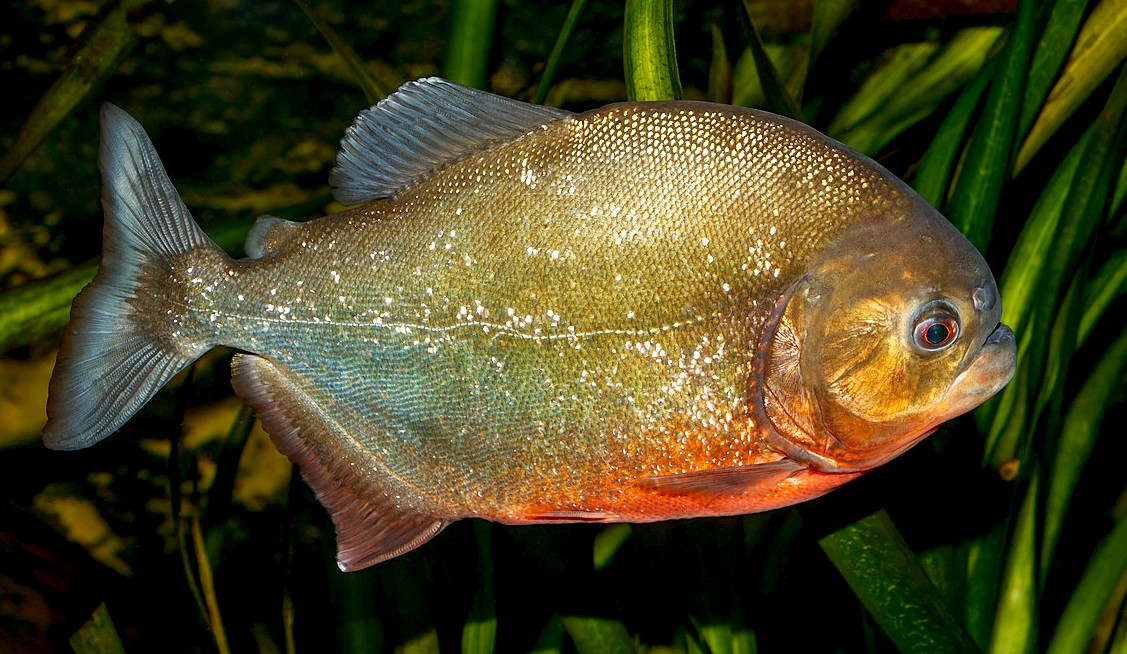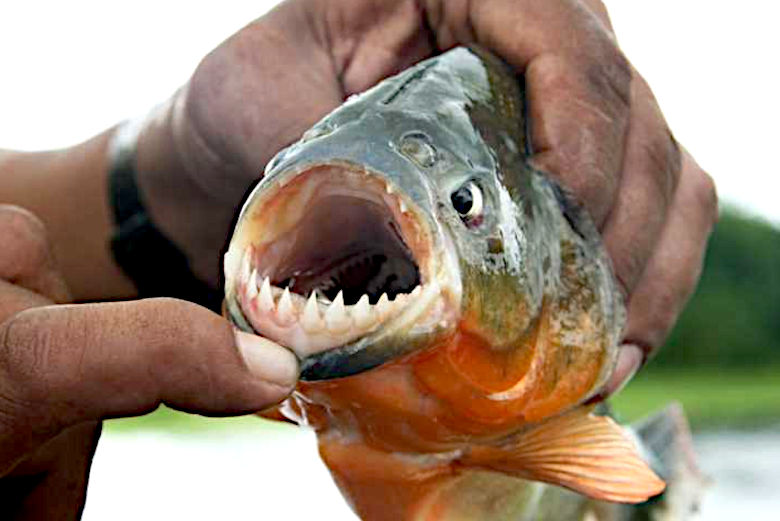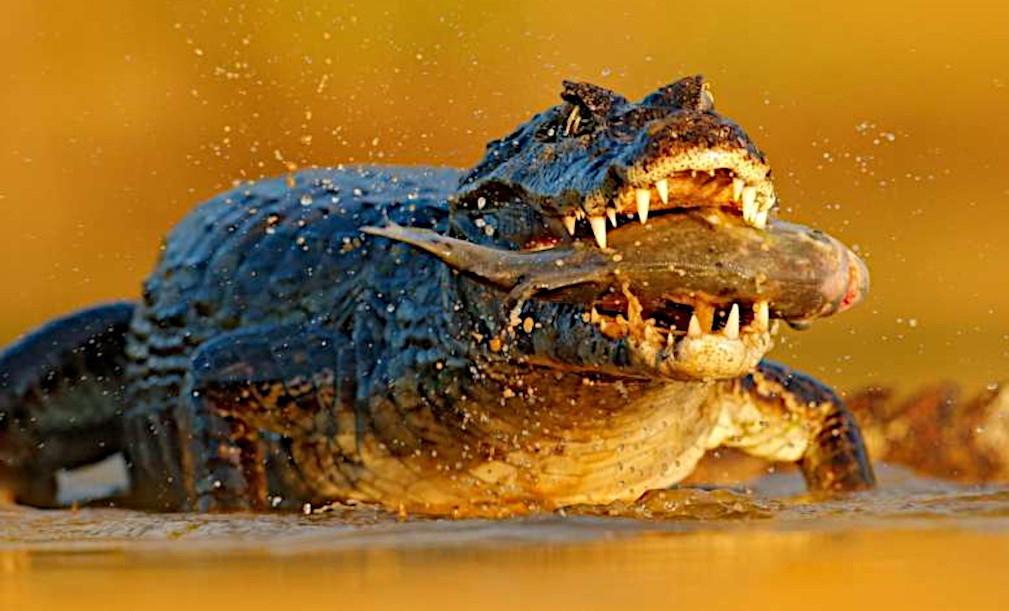|
PIRANHA
Please
use our A-Z
to navigate this site, or return HOME
Anchovies
| Bass
| Bream
| Catfish
| Clams
| Cod
Coley
| Crabs
| Crayfish
| Eels
| Grouper
| Haddock
| Hake
| Halibut
| Herring
| Jellyfish
Krill
| Lobster
| Mackerel
| Marlin
| Monkfish
| Mullet
| Mussels
| Oysters
| Perch
| Piranha | Plaice
| Pollock
| Prawns
| Rays
| Sablefish
| Salmon
Sardines
| Scallops
| Sharks
| Shrimp
| Skate
| Sole
| Sprat
| Squid
| Sturgeon
| Swordfish
| Trout
| Tuna
| Turbot
| Whiting

A
red bellied piranha in an aquarium in Germany
ABOUT
PIRANHA FISH
Piranhas are freshwater fish, ranging from northern Argentina to Colombia, but they are most diverse in the
Amazon
River, where 20 different species are found. The most infamous is the red-bellied piranha (Pygocentrus nattereri), with the strongest jaws and sharpest teeth of all. Especially during low water, this species, which can grow up to 50 cm (about 20 inches) in length, hunts in groups that can number more than 100. Several groups can converge in a feeding frenzy if a large animal is attacked, although this is rare.
Thanks to the work of Hollywood, many seem to believe that piranhas have an insatiable diet for blood, but as it turns out, they are actually omnivores – they eat animals and plants. Some species are also thought to be vegetarian. The 1978 movie titled simply “Piranha” got it all started and even had two sequels that followed. Piranha II – The Spawning (1981) and Piranha 3D (2010) pretty much scared anyone who wasn’t affected by
Jaws.
The discovery of piranhas at locations in Bangladesh and China is a cause for concern, as to how they got so far from their native habitat. There is as yet no clear answer as to how this could have happened, although they are thought to have been illegally brought into the country.
Piranhas are also popular as food. They are often considered a nuisance by fishers since they steal bait, eat catches, damage
fishing gear and may bite when accidentally caught.
Piranhas can be bought as pets in some areas but they are illegal in many parts of the United States and in the Philippines where importers face six months to four years in jail,
with the piranhas destroyed to prevent proliferation.
ATTACKS ON HUMANS
Most piranha attacks on humans only result in minor injuries, typically to the feet or hands, but they are occasionally more serious and very rarely can be fatal. Near the city of Palmas in Brazil, 190 piranha attacks, all involving single bites to the feet, were reported in the first half of 2007 in an artificial lake which appeared after the damming of the Tocantins River. In the state of São Paulo, a series of attacks in 2009 in the Tietê
River resulted in minor injuries to 15 people. In 2011, another series of attacks at José de Freitas in the Brazilian state of Piauí resulted in 100 people being treated for bites to their toes or heels. On 25 December 2013, more than 70 bathers were attacked at Rosario in Argentina, causing injuries to their hands or feet. In 2011, a drunk 18-year-old man was attacked and killed in Rosario del Yata, Bolivia. In 2012, a five-year-old Brazilian girl was attacked and killed by a shoal of P. nattereri. In February 2015, a six-year-old girl died after being attacked by piranhas when her grandmother's boat capsized during a vacation in Brazil. Whereas fatal attacks on humans are rare, piranhas will readily feed on bodies of people that already have died, such as drowning victims.

TWENTY PIRANHA FACTS
1. They have razor sharp teeth, with tooth enamel structure similar to that of sharks. The piranha has a single row of triangular teeth.
They will lose teeth throughout their lifetime and they will be replaced. The way in which their jaws are designed leave piranhas with a very distinct under bite, which means the bottom row of teeth are always exposed.
2. Piranha need warm water to survive. Piranhas can’t live in water that is less than 54-degrees F.
3. Theodore Roosevelt is thought to be somewhat to blame for their reputation.
After traveling to South America in 1913, the locals are said to have put on a show for him, by feeding a dead cow to a large group of hungry piranha. He subsequently wrote about the Piranha in his book ‘Through the Brazilian Wilderness’:
“They are the most ferocious fish in the world. Even the most formidable fish, the sharks or the barracudas, usually attack things smaller than themselves. But the piranhas habitually attack things much larger than themselves. They will snap a finger off a hand incautiously trailed in the water; they mutilate swimmers — in every river town in Paraguay there are men who have been thus mutilated; they will rend and devour alive any wounded man or beast; for blood in the water excites them to madness. They will tear wounded wild fowl to pieces; and bite off the tails of big fish as they grow exhausted when fighting after being hooked.”
4. The word ‘piranha’ means “fish tooth” in Amazonian indigenous languages. It is a rather descriptive name considering the teeth and mouth of the piranha.
5. In the wild, piranhas have a life span of up to 25 years. In captivity, they only live between 10 and 20 years.
6. The red-bellied piranha (Pygocentrus nattereri) is the most common of the species that you may see on display at aquariums almost everywhere.
7. Like sharks, piranhas have an “amazingly acute sense of smell” and this is what helps them in locating their next meal. It comes in handy as their eyesight is likely poor in the murky water piranha tend to like spending their time in.
8. The piranha respiratory system is the same as any other fish. They take water in through gills and absorb the oxygen that exists in that water. The oxygen is fed to the bloodstream and carbon dioxide is expelled through the gills.
9. The black and the red-bellied piranha can be aggressive towards humans, although actually attacking a full grown adult is highly unlikely and more myth, than fact.
10. The piranha jaw is strong, with the largest in the species being able to bite with a maximum force of 3 times their own body weight. The black piranha has the strongest bite force recorded for bony fish, according to a 2012 study by scientist Justin R. Grubich. A piranha can cut through a human hand in minutes.
11. The piranha can devour large animals if the animal happens to fall into water infested with piranhas. The main reason this happens is because piranha hunt in very large groups.
12. Piranhas rarely attack humans. Fatal attacks are even rarer, and most recorded cases have been where humans have already drowned.
13. A female piranha will lay about 5-thousand eggs. The male will fertilize them. The male piranha will protect the eggs so seriously that he will become territorial and will protect the eggs however he has to.
14. There are two spawning a year for piranha. The first one takes place in spring with the second in the late summer.
15. Native cultures in South America have used and continue to use piranha teeth for both tools and weapons, and they are also caught for food.
16. Piranhas can be bought as pets fo aquariums, but check your local laws as in most places it is illegal to have one.
17. Fossils have indicated that piranhas have been around for about 25 million years. The modern piranha genera is thought to have been around far less than that – a relatively shorter time – just 1.8 million years.
18. Research reveals that piranhas often attack the tail and eyes of other fish to immobilize them first. They also like to hunt in very large groups, sometimes upwards of 500 piranha. They will hunt together using what is described as the lurk and ambush style of attack. This is how they are capable of taking down a large animal.
19. Researchers have found piranhas were less stressed and calmer in a group for safety and protection, known as a ‘shoal’. While piranhas are often feared, they are prey themselves to crocodiles, caiman, river dolphins, large birds and turtles.
20. Red-bellied piranhas have been observed making bark-like noises when caught by fishermen. Studies show that they make three distinctive types of noises based upon different situations and behavior.

In
an effort to feed a
growing population we should look at
alternatives lower down the food chain to increase the ratio
at which protein is harvested from the ocean, so bypassing the
conventional food chain where at each stage of consumption
there are significant losses in the conversion process. Jellyfish,
squid, krill
and filter feeders such as mussels, could play a part in filling the widening gap between falling
fish stocks and higher demand to feed humans - so
relieving the pressure on tuna, salmon and other popular white
fish.
LINKS
& REFERENCE
https://

MARINE
LIFE - This humpback whale is one example of a magnificent
animal that is at the mercy of human
activity. Humans are for the most part unaware of the harm their fast-lane
lifestyles are causing. We aim to change that by doing all we
can to promote ocean
literacy.
Anchovies
| Bass
| Bream
| Catfish
| Clams
| Cod
Coley
| Crabs
| Crayfish
| Eels
| Grouper
| Haddock
| Hake
| Halibut
| Herring
| Jellyfish
Krill
| Lobster
| Mackerel
| Marlin
| Monkfish
| Mullet
| Mussels
| Oysters
| Perch
| Piranha |
Plaice
| Pollock
| Prawns
| Rays
| Sablefish
| Salmon
Sardines
| Scallops
| Sharks
| Shrimp
| Skate
| Sole
| Sprat
| Squid
| Sturgeon
| Swordfish
| Trout
| Tuna
| Turbot
| Whiting
Please
use our A-Z
to navigate this site, or return HOME
This
website is provided on a free basis as a public information
service. Copyright © Cleaner
Oceans Foundation Ltd (COFL) (Company No: 4674774)
2022. Solar
Studios, BN271RF, United Kingdom.
COFL
is a charity without share capital.
|



